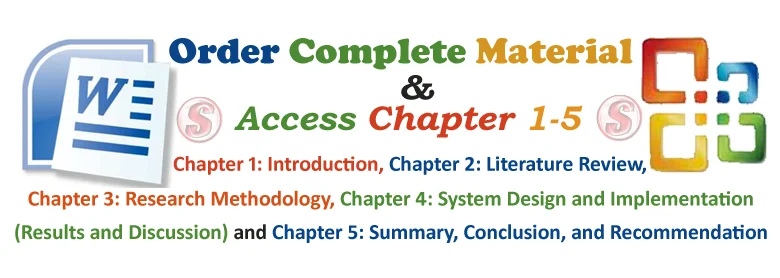1.1 Introduction
Mathematical anxiety is situations that happen to some people when facing a mathematical problem. Good feeling towards mathematics brings good perception about mathematics, and vice versa. Emotions play the most important part in this situation. According to Wondimu et al. (2012), the uneasy feeling such as panic, clueless and helplessness when working on something related to mathematics tends to affect the mathematical performance especially for students. They also found that mathematical self-concept and mathematical anxiety are reciprocally related (Wondimu et al., 2012). Mathematics anxiety occurs in primary and elementary students (Cargnelutti et al., 2017; Jameson, 2013, 2014), secondary students (Passolunghi et al., 2016), and traditional college students (Hendy et al., 2014).
As a prelude to other parts of this study, this chapter will discuss the background upon which this study was initiated, the statement of problems that led to this study, the Aim and Objectives of the study. Others are Significance of the study, Scope of work, Research hypothesis and questions, Limitation of the study and Definition of terms.
1.2 Background of Study
Over the years, Mathematics is regarded as one of the most important subjects in University admission criteria. Thus it is made compulsory for all students to offer at the JAMB examinations before they can be admitted into any higher institution of learning in Nigeria. This is because Nigeria as a nation solely depends upon mathematics as one of the most important subjects that could help the nation meet her objective for science and technological advancement (Jegede, 2002).
It is a fact that students have a very low interest in mathematics. Students hate or dislike mathematics. Even at secondary schools level in Nigeria students do not attend mathematics lessons (Fatola, 2005). Those who attend the mathematics lessons do not pay attention to the teacher. Most of the students do not practice mathematics on their own neither do they solve mathematics problems on their own.
According to Aarnos and Perkkila (2012) study, mathematic anxiety can be caused by environmental factor. He stated that negative experience with parents or teachers in viewing mathematical might affect their children as negative attitudes and beliefs. This finding supported by Maryam et al. (2010) describes that students will affect mathematic attitudes such as try to avoid mathematic course with negative attitudes and belief in mathematics. This will result their ability to successful to complete mathematical problems. It also can affect the performance of students in academic field with a mathematical component as mentioned by Nunez-Pena et al. (2013).
According to Amazigo (2000), when the option is available, many students would prefer not to have anything to do with learning mathematics. This attitude has led them, among other things, to achieve poorly in mathematics examinations both internal and external. On the other hand, the recent paucity and anxiety of undergraduates in mathematics and mathematics education in Universities, Colleges of Education and Polytechnics suggests that mathematics is no longer popular among students particularly at the higher institution level. There is no doubt that the poor achievement in the subject enhances students’ hatred for the subject. This hatred is rooted in the fact that there is a general tendency for students to fear mathematics whenever it is mentioned (Amazigo, 2000).
In intensity it varies from a mild sense of apprehension to paralyzing terror. In anxiety there is always the desire to shrink, to get away or retreat from the exciting cause. The stimuli for anxiety are many and varied. In early infancy any sudden or intense stimuli like loud and sudden noise, unexpected jerk, and flash of bright light or loss of support may cause anxiety though there are large individual differences. Any sudden change in the environment, which the individual regards as threatening and for which he is unprepared, produces anxiety. When the threatening situation is removed or controlled, and the danger real or imaginary has passed, anxiety disappears. Also, as activities or experiences expand or interests and abilities grow, the number and kinds of anxiety increase. But as the power of adjustment through experience increases many of childish anxiety disappear.
Some anxieties are as a result of conditioning effect. They will have to be reconditioned by attaching pleasant circumstances and experiences with situations and objects, which causes the anxiety. Praise or rewards attached to or associated with fearful tasks or situations will help to reduce anxiety. There are some anxiety where the best thing to do is to act as the anxiety suggests, that is, get away. This would be true in the case of a poisonous snake, and mad dog. However, with other anxieties we need to face it, we must have courage (Stephen, 2007).
Stephen (2007) describes mathematics anxiety as an academic disease whose virus has not yet been diagnosed for an effective treatment in the class, though the symptoms of this anxiety are always expressed on the faces of the learners in mathematics classes. This disease (otherwise known as pathological fear), is communicable as it is usually distributed to sciences that are mathematics related.
Pathological mathematics anxiety therefore means a behaviour disorder in which an individual becomes progressively unable to resist the impulse to fear mathematics. It is an abnormal and persistent dread of mathematics; sufferers usually experience undue anxiety even though they may rationally realize that mathematics does not pose a threat commensurate with their anxiety (Amazigo, 2000).
Therefore, in Nigeria, where the research was carried out, the activities that was conducted is to know the Perception of Students on the Causes and Effects of Mathematics Anxiety Among Students of Tertiary Institutions.
1.3 Statement of Problems
Investigation revealed that larger number of students tends to choose non mathematics related courses while seeking admission to higher institutions. The number of students offering non mathematics related courses in higher institution is more than ten times the number offering mathematics related courses. This can be related to mathematics anxiety. Students perceives mathematics as a very difficult subject which is difficult to understand, hence they spent little time, interest and concentration on it. However, the researcher is examining the Perception of Students on the Causes and Effects of Mathematics Anxiety Among Students of Tertiary Institutions.
1.4 Aim and Objectives of Study
The aim of the study is to examine the Perception of Students on the Causes and Effects of Mathematics Anxiety Among Students of Tertiary Institutions. In achieving this aim, the following specific objectives were laid out as follows:
- To examine the perception of students on the causes of mathematics anxiety among students of tertiary institutions;
- To investigate the factors which lead students of Tertiary Institutions to feel mathematical anxiety;
- To examine the perception of students on the effects of mathematics anxiety among students of tertiary institutions;
- To find out how anxiety affect students’ learning and academic achievements; and
- To identify the solution to the problem of mathematics anxiety among students of tertiary institutions.
1.5 Research Questions
The study came up with research questions so as to be able to ascertain the above stated objectives. The specific research questions for the study are stated below as follows:
- How does this anxiety affect their learning and academic achievements?
- What are the factors which lead students to feel mathematical anxiety?
- What is the perception of students on the causes of mathematics anxiety among students of tertiary institutions?
- What is the perception of students on the effects of mathematics anxiety among students of tertiary institutions?
- What is the solution to the problem of mathematics anxiety among students of tertiary institutions?
1.6 Research Hypothesis
In order to pursue the objective of this study, the following generalized statements have been designed to guide and aids in obtaining the result for the experiment to be conducted. For this work, the null hypothesis will be represented with H0 while the alternative hypothesis will be represented with hypothesis H1.
Hypothesis One
- H0: There are no significant factors which lead students of Tertiary Institutions to feel mathematical anxiety
- H1: There are significant factors which lead students of Tertiary Institutions to feel mathematical anxiety
1.7 Significance of Study
The outcome of this study will educate the students of higher institutions and the general public on the Perception of Students on the Causes and Effects of Mathematics Anxiety Among Students of Tertiary Institutions.
This research will be a contribution to the body of literature in the area of the effect of personality trait on student’s academic performance, thereby constituting the empirical literature for future research in the subject area.
1.8 Scope of Study
The scope of the research is focused on the Perception of Students on the Causes and Effects of Mathematics Anxiety Among Students of Tertiary Institutions. This research is restricted to students of the University of Benin (UNIBEN) in Edo State.
1.9 Limitations of the Study
During the course of this study, many things militated against its completion, some of which are:
- Time Constraint: The time frame given to accomplish this project was very short due to school academic calendar and it was carried out under pressure which made the researcher not to implement some necessary features.
- Financial Constraint: Insufficient fund tends to impede the efficiency of the researcher in sourcing for the relevant materials, literature or information and in the process of data collection (internet, questionnaire and interview).
1.10 Definition of Terms
Mathematics Anxiety:
It is an academic disease whose virus has not yet been diagnosed for an effective treatment in the class, though the symptoms of this anxiety are always expressed on the faces of the learners in mathematics classes (Stephen, 2007).
Pathological Mathematics Anxiety:
It means a behaviour disorder in which an individual becomes progressively unable to resist the impulse to fear mathematics (Amazigo, 2000).




